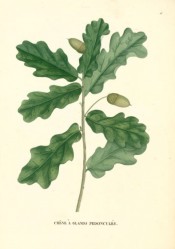Quercus robur L.
Fully-hardy, spreading deciduous tree with fissured bark, oblong leaves with rounded lobes, to 14cm long, and single or small clusters of acorns. To 35m. [RHSE, Hortus, Hilliers’].
Horticultural & Botanical History
The value of oak timber is well known but in times past the English Oak was also useful for other purposes. ‘This valuable tree is well known to be a native of Britain, where it has in some instances acquired an extraordinary magnitude: its wood is of general use in carpentry, and by uniting hardness with such a degree of toughness as not easily to splinter, has been long justly preferred for the purpose of building ships.
The astringent effects of the Oak were sufficiently known to the ancients, by whom different parts of the tree were used; but it is the bark which is now directed for medicinal use by our pharmacopeias. To this tree we may also refer the Gallae, or Galls, which are produced from its leaves by means of a certain insect.
Oak bark manifests to the taste a strong astringency, accompanied with a moderate bitterness, qualities which are extracted both by water and by rectified spirit. Its universal use and preference in the tanning of leather is a proof of its great astringency, and like other astringents it has been recommended in agues, and for restraining haemorrhagies, alvine fluxes, and other immoderate evacuations. A decoction of it has likewise been advantageously employed as a gargle, and as a fomentation or lotion in procidentia recti et uteri. Dr. Cullen tells us, that he has frequently employed the decoction with success in slight tumefactions of the mucous membrane of the fauces, and in many prolapsus uvulae, and cynanche tonsillaris, to which some people are liable upon the least exposure to cold: and in many cases this decoction, early applied, has appeared useful in preventing these disorders. It must be remarked however, that the Dr. almost constantly added a portion of alum to these decoctions.’ [Medical Botany p.25/1790-93].
Saint-Hilaire Arb. pl.15/1824.
History at Camden Park
Listed in all published catalogues [T.806/1843]. Probably a very early introduction to the gardens. Edward Macarthur provided seed to the Sydney Botanic Garden in 1823. He obtained it from the Isle de France. There are several large specimens in the gardens and a larger number in the English Woodland between the gardens and the Nepean River.
Notes
Quercus pedunculata Nee ex A.DC. (1864) = Quercus tomentosa Willd.
Published Feb 03, 2010 - 03:39 PM | Last updated Feb 03, 2010 - 03:44 PM
| Family | Fagaceae |
|---|---|
| Category | |
| Region of origin | Europe to Asia |
| Synonyms |
|
| Common Name | Common oak, English oak, Pedunculate oak |
| Name in the Camden Park Record |
Quercus pedunculatus - English Oak |
| Confidence level | high |
